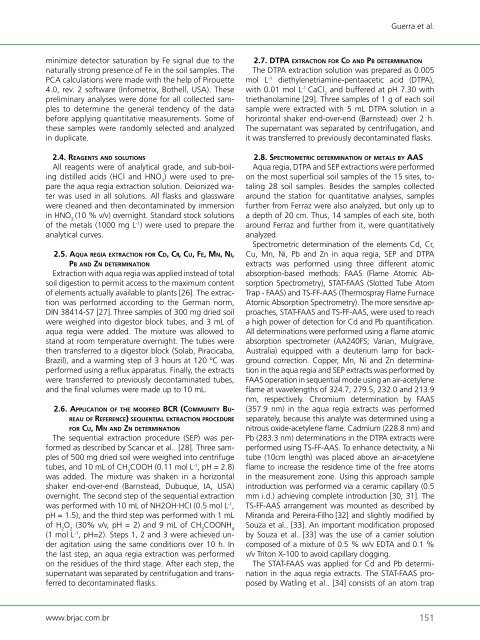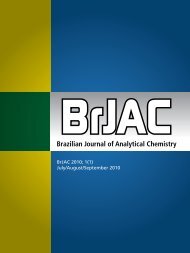Brazilian Journal of Analytical Chemistry - BRJAC - Brazilian Journal ...
Brazilian Journal of Analytical Chemistry - BRJAC - Brazilian Journal ...
Brazilian Journal of Analytical Chemistry - BRJAC - Brazilian Journal ...
Create successful ePaper yourself
Turn your PDF publications into a flip-book with our unique Google optimized e-Paper software.
minimize detector saturation by Fe signal due to the<br />
naturally strong presence <strong>of</strong> Fe in the soil samples. The<br />
PCA calculations were made with the help <strong>of</strong> Pirouette<br />
4.0, rev. 2 s<strong>of</strong>tware (Infometrix, Bothell, USA). These<br />
preliminary analyses were done for all collected samples<br />
to determine the general tendency <strong>of</strong> the data<br />
before applying quantitative measurements. Some <strong>of</strong><br />
these samples were randomly selected and analyzed<br />
in duplicate.<br />
2.4. re a g e n t s a n d s o l u t Io n s<br />
All reagents were <strong>of</strong> analytical grade, and sub-boiling<br />
distilled acids (HCl and HNO 3 ) were used to prepare<br />
the aqua regia extraction solution. Deionized water<br />
was used in all solutions. All flasks and glassware<br />
were cleaned and then decontaminated by immersion<br />
in HNO 3 (10 % v/v) overnight. Standard stock solutions<br />
<strong>of</strong> the metals (1000 mg L -1 ) were used to prepare the<br />
analytical curves.<br />
2.5. aq u a r e g Ia extractIon f o r cd, cr, cu, fe, mn, nI,<br />
pb a n d zn determInatIon<br />
Extraction with aqua regia was applied instead <strong>of</strong> total<br />
soil digestion to permit access to the maximum content<br />
<strong>of</strong> elements actually available to plants [26]. The extraction<br />
was performed according to the German norm,<br />
DIN 38414-S7 [27]. Three samples <strong>of</strong> 300 mg dried soil<br />
were weighed into digestor block tubes, and 3 mL <strong>of</strong><br />
aqua regia were added. The mixture was allowed to<br />
stand at room temperature overnight. The tubes were<br />
then transferred to a digestor block (Solab, Piracicaba,<br />
Brazil), and a warming step <strong>of</strong> 3 hours at 120 ºC was<br />
performed using a reflux apparatus. Finally, the extracts<br />
were transferred to previously decontaminated tubes,<br />
and the final volumes were made up to 10 mL.<br />
2.6. applIcatIon o f t h e modIfIed bcr (co m m u n It y bu-<br />
r e a u o f reference) sequentIal extractIon p r o c e d u r e<br />
f o r cu, mn a n d zn determInatIon<br />
The sequential extraction procedure (SEP) was performed<br />
as described by Scancar et al.. [28]. Three samples<br />
<strong>of</strong> 500 mg dried soil were weighed into centrifuge<br />
tubes, and 10 mL <strong>of</strong> CH 3 COOH (0.11 mol L -1 , pH = 2.8)<br />
was added. The mixture was shaken in a horizontal<br />
shaker end-over-end (Barnstead, Dubuque, IA, USA)<br />
overnight. The second step <strong>of</strong> the sequential extraction<br />
was performed with 10 mL <strong>of</strong> NH2OH . HCI (0.5 mol L -1 ,<br />
pH = 1.5), and the third step was performed with 1 mL<br />
<strong>of</strong> H 2 O 2 (30% v/v, pH = 2) and 9 mL <strong>of</strong> CH 3 COONH 4<br />
(1 mol L -1 , pH=2). Steps 1, 2 and 3 were achieved under<br />
agitation using the same conditions over 10 h. In<br />
the last step, an aqua regia extraction was performed<br />
on the residues <strong>of</strong> the third stage. After each step, the<br />
supernatant was separated by centrifugation and transferred<br />
to decontaminated flasks.<br />
www.brjac.com.br<br />
Guerra et al.<br />
2.7. dtpa extractIon f o r cd a n d pb determInatIon<br />
The DTPA extraction solution was prepared as 0.005<br />
mol L -1 diethylenetriamine-pentaacetic acid (DTPA),<br />
with 0.01 mol L -1 CaCl 2 and buffered at pH 7.30 with<br />
triethanolamine [29]. Three samples <strong>of</strong> 1 g <strong>of</strong> each soil<br />
sample were extracted with 5 mL DTPA solution in a<br />
horizontal shaker end-over-end (Barnstead) over 2 h.<br />
The supernatant was separated by centrifugation, and<br />
it was transferred to previously decontaminated flasks.<br />
2.8. spectrometrIc determInatIon o f metals b y aas<br />
Aqua regia, DTPA and SEP extractions were performed<br />
on the most superficial soil samples <strong>of</strong> the 15 sites, totaling<br />
28 soil samples. Besides the samples collected<br />
around the station for quantitative analyses, samples<br />
further from Ferraz were also analyzed, but only up to<br />
a depth <strong>of</strong> 20 cm. Thus, 14 samples <strong>of</strong> each site, both<br />
around Ferraz and further from it, were quantitatively<br />
analyzed.<br />
Spectrometric determination <strong>of</strong> the elements Cd, Cr,<br />
Cu, Mn, Ni, Pb and Zn in aqua regia, SEP and DTPA<br />
extracts was performed using three different atomic<br />
absorption-based methods: FAAS (Flame Atomic Absorption<br />
Spectrometry), STAT-FAAS (Slotted Tube Atom<br />
Trap - FAAS) and TS-FF-AAS (Thermospray Flame Furnace<br />
Atomic Absorption Spectrometry). The more sensitive approaches,<br />
STAT-FAAS and TS-FF-AAS, were used to reach<br />
a high power <strong>of</strong> detection for Cd and Pb quantification.<br />
All determinations were performed using a flame atomic<br />
absorption spectrometer (AA240FS; Varian, Mulgrave,<br />
Australia) equipped with a deuterium lamp for background<br />
correction. Copper, Mn, Ni and Zn determination<br />
in the aqua regia and SEP extracts was performed by<br />
FAAS operation in sequential mode using an air-acetylene<br />
flame at wavelengths <strong>of</strong> 324.7, 279.5, 232.0 and 213.9<br />
nm, respectively. Chromium determination by FAAS<br />
(357.9 nm) in the aqua regia extracts was performed<br />
separately, because this analyte was determined using a<br />
nitrous oxide-acetylene flame. Cadmium (228.8 nm) and<br />
Pb (283.3 nm) determinations in the DTPA extracts were<br />
performed using TS-FF-AAS. To enhance detectivity, a Ni<br />
tube (10cm length) was placed above an air-acetylene<br />
flame to increase the residence time <strong>of</strong> the free atoms<br />
in the measurement zone. Using this approach sample<br />
introduction was performed via a ceramic capillary (0.5<br />
mm i.d.) achieving complete introduction [30, 31]. The<br />
TS-FF-AAS arrangement was mounted as described by<br />
Miranda and Pereira-Filho [32] and slightly modified by<br />
Souza et al.. [33]. An important modification proposed<br />
by Souza et al.. [33] was the use <strong>of</strong> a carrier solution<br />
composed <strong>of</strong> a mixture <strong>of</strong> 0.5 % w/v EDTA and 0.1 %<br />
v/v Triton X-100 to avoid capillary clogging.<br />
The STAT-FAAS was applied for Cd and Pb determination<br />
in the aqua regia extracts. The STAT-FAAS proposed<br />
by Watling et al.. [34] consists <strong>of</strong> an atom trap<br />
151



